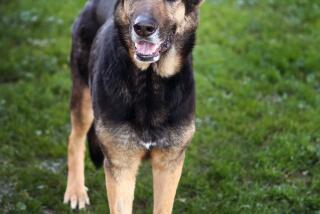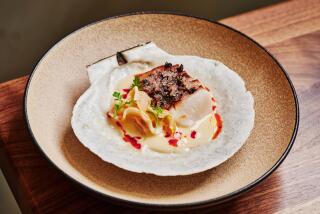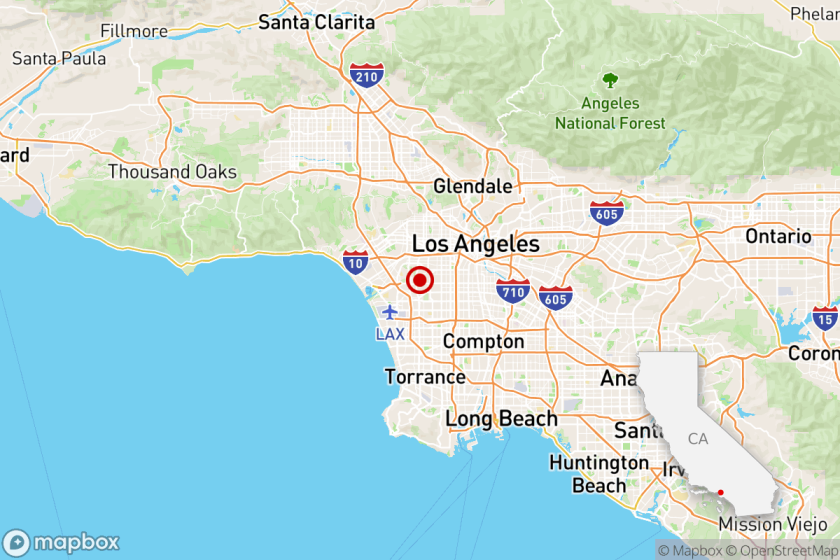From Dodger Dogs to organic franks, L.A. is a hot dog town

LOS ANGELES is burgerville, but we love our hot dogs too. A lot. This is the No. 2 dog-eating town in the country, right after New York. It’s no accident that Wienerschnitzel, the world’s largest hot dog chain, was born in Wilmington.
We have our old-time dog houses such as Pink’s in Hollywood, Cupid’s in Northridge and the notorious Oki Dog, with its indefensible topping of pastrami and cheese. A lot of Angelenos are waiting to find out what will happen to Hollywood’s famous Tail o’ the Pup stand, which has languished in a warehouse since 2005. Look on the Internet and you can read of the grief felt when Sherman Oaks’ 36-year-old Wiener Factory closed last New Year’s Eve.
FOR THE RECORD:
Cafe Surfas phone number: In a Food section article on Tuesday listing places with the best premium hot dogs, the phone number for Cafe Surfas in Culver City was incorrect. The correct number is (310) 558-1458. —
(Speaking of the Internet, there’s an L.A. hot dog lovers’ blog, www.hotdogspot.com. Hot Dog Spot posts are infrequent, but the site crashed briefly last month for excess traffic, indicating a willing if not well-served fan base.)
Finally -- love ‘em or hate ‘em -- Dodger Stadium would not be Dodger Stadium without Dodger Dogs.
Hot dogs are the ultimate vernacular food, you’d say, but these days they’re going gourmet. The L.A. area now has a number of doggeries that extol special features of their sausages. City Bakery in Brentwood has an organic beef dog; Cafe Surfas in Culver City uses smoked venison.
I’m all for this phenomenon. Our wienie scene is long established, but it can use new blood. The Cupid’s chain I grew up on seems to be declining, and I’ve never been a fan of the sausage they use at Pink’s (I know, I know, it has a million fans; so shoot me). Let a million franks bloom, particularly when they’re as good as this new wave. It can only enrich our lives.
Riding the snap
MOST of the new places insist on natural lamb gut casings, which snap when you bite into the sausage, providing a burst of sausage juices in the mouth. “Without the natural casing,” insists John Hooper of Skooby’s in Hollywood, “a hot dog is not a sausage, it’s just a Kraft meat product.”
Several newcomers follow the New York grilled dog tradition, but there’s a surge of interest in the Chicago school: a boiled dog on a poppy seed bun, seasoned with mustard and celery salt and piled with chopped onions, tomato chunks, a pickle spear, pickled sport peppers (a variety of small green peppers) and a lurid green pickle relish.
Local branches of Chicago chains Portillo’s and Mustard’s have opened -- the former in Buena Park and Moreno Valley, the latter in Los Alamitos.
L.A.’s new breed of dogateurs don’t just set up a counter and some stools, they tend to have a vision. “I use the slogan ‘Fast Food for the Discerning,’ ” says Marty Davidson of Marty D’s in Beverly Hills. “I thought of it as a place for people who want to have a nice experience and not spend a fortune.”
“Our motivation was to pay homage to the hot dog as an iconic American food,” says Murray Wishengrad of the Stand chain ( Encino, Century City and Westwood), “to elevate the hot dog in both quality and environment. All our places have beer and wine licenses, so you can have a glass of Merlot with a great hot dog.”
We’ve been familiar with wieners (or frankfurters, whatever you want to call them) at least since 1888, when they were first mentioned in The Times -- well ahead of the world’s fairs of the 1890s that supposedly introduced them to this country, by the way -- in a jokey column about L.A.’s reputation as a rough place where hogs were supposedly fed on stolen registered mail and then turned into “wiener wurst.”
And we’ve had premium hot dog stands before. Jody Maroni’s, on the Venice boardwalk since 1979, spawned a chain and a national brand of sausages (Maroni is health-conscious these days, so you might want to some salt on his dogs). Johnnie’s Pastrami in Culver City, vintage 1952, still features a huge, meaty grilled dog.
The Carney’s railway car restaurants in Hollywood and Studio City, which date from the ‘60s and ‘70s, have a dog with an impressive snap, followed by rich juices, as if you’ve bitten into a very warm Slim Jim.
Some of today’s ambitious dogaterias seem to be stretching the definition of the hot dog to mean any sausage that fits in a hot dog bun.
Properly, though, it’s a mild, smooth-textured sausage of beef, pork or a combination, lightly smoked and flavored with paprika and a sweet spice such as coriander or nutmeg. Old recipes don’t always include garlic, but it’s now standard.
The hot dog originated around Frankfurt am Main, Germany, in the mid-1600s and made its way to Vienna around 1804. It arrived in this country from Germany and Austria simultaneously, which is why we call it either a frankfurter or wiener. Some American sausage makers now make the distinction that a wienie is blander than a frank.
It’s made by grinding the meat very fine with seasonings and ice water, stuffing it in sausage casings, giving it a smoke flavor and cooking it in hot water (all hot dogs are precooked).
The DIY dog
YOU CAN make respectable hot dogs yourself if you have a sausage stuffing attachment on your meat grinder and can get lamb gut sausage casings. Butchers who make their own sausage may sell you some, or you can go online to sites such as www.sausagemaker.com or www.leeners.com, which also provide hot dog recipes.
The traditional frankfurter was smoked in a smokehouse, which requires adding “quick cure” (also called Prague powder No.1), a precise mixture of table salt and sodium nitrite, usually dyed pink so nobody will mistake it for regular salt. If you smoke sausage with no sodium nitrite, you face a serious danger of botulism poisoning.
But don’t worry. Guests are always amazed when you can produce something like the commercial product they know, so they’ll actually be more impressed by your franks if you add just a few drops of liquid smoke, the way commercial hot dog companies have long done. For once, the easy way is the splashiest.
More to Read
Start your day right
Sign up for Essential California for news, features and recommendations from the L.A. Times and beyond in your inbox six days a week.
You may occasionally receive promotional content from the Los Angeles Times.






